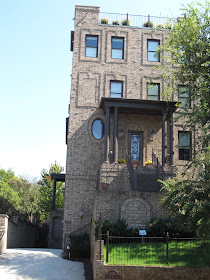Posted by
Chandra Ward, ATLANTA, GA -- As a Metro Atlanta native, I’ve always known that
the north side of Atlanta was affluent White and the south side a mixture of
affluent, middle, working, and poor Blacks. This is Part Two of my series on Atlanta's racialized infrastrucutre. Generations of my family have lived
on the south side and continue to do so, although some of us moved to Cobb
County, a northern suburb of Atlanta. But don't be fooled, even us suburban
Wards live in segregated neighborhoods.
What's most interesting, however, is the role Interstate-20 (I-20) has
played in slicing the region like moon cookie all in the name of relieving
traffic congestion.
Urban renewal initiatives beginning in the early 1950s were supposed to save the declining inner city by better connecting it to the thriving and growing suburbs, which at that point were mostly White. In Atlanta this took the form of the Downtown Connector (I-75 and I-20). While this 'Connector' certainly did address traffic congestion, it also served as a politically expedient way to reinforce racial segregation, racial disenfranchisement, and oppression. In fact, through the imposition of the Connector, thriving downtown Black business districts and communities were essentially destroyed. I-75 ran to the north and south and allowed the White northern suburbs to become annexed by the city in order to maintain a White majority. I-20, dissected the city from east to west, allowing for the expansion of downtown, an expansion that literally cut off the Black business districts from enterprise.
It's important
to note that the Connector also led to widespread destruction of low-income
neighborhoods downtown and the relocation of thousands of low-income, mostly
Black residents, because it cut right through Auburn Avenue. This area was known
as “Sweet Auburn” -- a smaller-scale equivalent to Chicago's 47th Street and
Harlem's 25th. It was once home to many of the city’s most successful black
businesses, including the Atlanta Family Life Insurance Company, owned by
Atlanta’s first Black millionaire, Alonzo Herndon. Auburn Avenue was the heart of Black
business, art, political, and intellectual life. For this reason, John Wesley Dobbs, the
unofficial mayor of Auburn Avenue, coined the street’s nickname Sweet Auburn,
“the richest Negro street in the world.” It's also the home to Ebenezer Baptist
Church, where the late Dr. Martin Luther King, Jr. was once Pastor. The avenue
represents the accomplishments of a determined people, who, despite living in
the midst of Jim Crow South, created their own American Dream independent from
Whites.
Auburn Avenue is
now designated as a historical district. Gentrification has taken hold in some
locations but you're more likely to see evidence of poverty. So what happened to the
Black American Dream? Well, it got destroyed by the federal bulldozer on Auburn
despite the fact that there is now a national park dedicated to Martin Luther
King Jr. right on the Avenue. This is a place where tourists flock. But the
community gets none of the benefits, although there are murals celebrating Civil
Right icon and Senator, John Lewis. Still, in my mind, the Connector rather
ironically disconnected civil rights and fair integration for those who made
the area what it once was, as well as for future generations.
Chandra Ward is a doctoral student in Sociology at Georgia State University and the Assistant Editor of Social Shutter. She can be reached at chandradward@gmail.com.






























